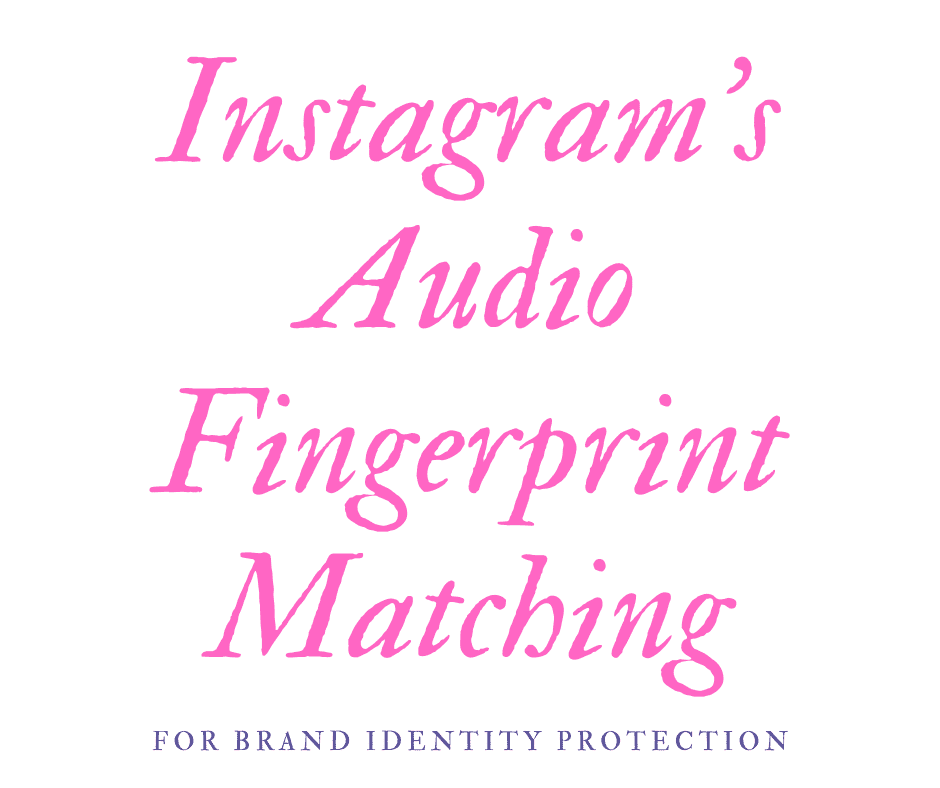Last Updated on April 22, 2025 by Val Razo
In today’s era of generative AI, the need for robust tools that help creators protect their music, images, and other digital content has never been more urgent. Platforms like Instagram are leading the way with innovations such as audio fingerprint matching, which creates a unique digital fingerprint of your audio to help detect unauthorized use, deepfake audio, and even AI-generated content. This technology is part of a broader movement to safeguard intellectual property, especially in industries like the music industry where content is constantly being shared online.
By using a combination of biometric authentication, digital watermarking, and authentication methods, creators gain an extra layer of protection when uploading their work to digital platforms like TikTok, YouTube, and Instagram. These technologies don’t just verify the source of the content — they help enhance security, protect privacy and security, and enable better data privacy practices in line with frameworks like the EU’s General Data Protection Regulation (GDPR) and the EU AI Act.
This article will explore how to use Instagram’s audio fingerprint matching for brand identity protection, explain how it helps authenticate content, and break down how fingerprinting systems, biometric data, and other authentication solutions work together to keep digital media secure. We’ll also explore use cases, best practices, and what brands need to know to stay one step ahead in a world of deepfake technology and AI-generated images.
Understanding Audio Fingerprint Matching on Instagram
What is audio fingerprinting and how does it work?
Audio fingerprinting is a form of digital fingerprint technology designed to create a unique identifier for every piece of audio content. This identifier — much like a fingerprint — remains consistent, even if the file is compressed, clipped, or slightly altered. Instagram uses this technology to match uploaded content against a massive database, allowing for quick and efficient detection of unauthorized use across the platform.
At its core, audio fingerprinting breaks down sound into short snippets and transforms them into numerical patterns. These patterns are then stored as a content ID in a database. When someone uploads a video or audio file, Instagram’s detection tools scan the audio to see if it matches any existing fingerprinting systems. This helps identify AI-generated, pirated, or reused content — especially when the original creator is not credited.
What makes this even more powerful is that it’s an automated form of authentication, meaning creators don’t need to manually monitor every upload or report each misuse. Instead, Instagram’s AI detects potential violations in real time, making the platform a more secure space for musicians, brands, and influencers.
How biometric data helps authenticate and safeguard branded content
In more advanced systems, biometric data — such as voice authentication — adds another layer of security. When combined with audio fingerprinting, biometric elements enable the platform to not only verify authenticity, but also safeguard content from deepfake audio or AI-generated imitations that may sound eerily similar to original creators.
This is especially critical in the music industry, where vocal styles, lyrics, and musical arrangements are often mimicked by AI-generated content. The ability to analyze and authenticate the actual biometric information in a piece of music ensures creators can protect their work, file copyright claims, and defend their digital rights.
As concerns grow over privacy and security on digital platforms, these kinds of authentication solutions are becoming essential for technology and media companies. Not only do they offer a way to track original content, but they also contribute to broader goals of data privacy and privacy protection in line with regulations like GDPR.
After finding my track reposted without credit on TikTok, I used an audio fingerprinting tool to trace the upload. Within hours, I filed a claim through Instagram and had the post taken down — no hassle, no lawyers.
Why AI Matters in Brand Protection
Detecting AI-generated content and deepfakes
With the rapid rise of generative AI, it’s become increasingly difficult to distinguish between real and synthetic content. This poses a serious risk for creators and brands trying to protect their work across digital platforms. From deepfake audio to fully AI-generated images, the need to detect and control how your brand appears online has never been more critical.
Instagram’s AI detection tools work by identifying patterns, inconsistencies, and embedded digital fingerprints that may reveal whether content has been artificially generated. These tools can help verify authenticity and flag potentially harmful or misleading posts before they go viral — including unauthorized uses of music, voice, or likeness.
Being able to identify AI-generated media also helps brands fight impersonation, misinformation, and unauthorized use of their intellectual property. It’s an essential part of modern security measures in the fight against deepfake technology, especially as these tools grow more accessible and convincing.
Biometric authentication and digital rights management
At the intersection of AI and content protection lies biometric authentication — an advanced method that uses elements like voice, facial features, or even music style to authenticate a piece of media. When layered into platforms like Instagram, this form of authentication can be used to embed and analyze a unique digital fingerprint that traces back to the original creator.
For musicians and creators, this means greater control over digital rights. AI-based authentication solutions can automatically enforce copyright claims, protect sensitive information, and limit the reach of imposters who use a brand’s identity without permission.
From an industry-wide standpoint, combining AI-generated content detection with biometric data is a powerful tool for safeguarding creative assets and ensuring they are used responsibly — especially in an age where music, video, and graphics are so easily duplicated and reshared.
As regulations like the EU AI Act and GDPR begin to shape the digital future, these technologies not only enhance privacy protection, but also help set a global standard for ethical and secure content creation.
Using AI Watermarking to Protect Your Music and Brand Identity
How watermarking supports fingerprinting technology
While audio fingerprinting excels at tracking and identifying reused content, AI watermarking adds another layer by embedding hidden, persistent metadata directly into a file. Think of it as a silent signature — one that stays intact even if the content is altered, shared, or reposted across multiple digital platforms like Instagram, TikTok, and YouTube.
By embedding a unique identifier into audio or visual content, watermarking complements fingerprinting systems by making it easier to detect AI-generated alterations, unauthorized use, or piracy. Watermarks also help authenticate the origin of content, making them ideal for brands and artists who want to safeguard their digital rights while distributing content widely online.
This dual approach — combining fingerprinting and watermarking — is becoming the industry standard for creators looking for an extra layer of protection in today’s evolving technology and media landscape.
Best practices for audio watermarking on social platforms
To maximize protection while maintaining quality, creators should follow these best practices when applying AI watermarking:
-
Use subtle, non-intrusive watermarks: Watermarks should not affect the listening experience or quality of the audio. Many tools today allow for invisible embedding.
-
Embed both ownership and usage data: Include details like author name, original upload timestamp, and usage permissions. This data supports authentication methods and copyright claims down the line.
-
Combine watermarking with biometric cues: Where possible, pair watermarking with biometric authentication such as voice authentication to create a stronger identity profile for your content.
-
Update watermarking tools regularly: As deepfake and AI-generated content evolve, ensure your watermarking technology stays current to maintain effectiveness.
-
Stay compliant with privacy laws: Always ensure embedded data complies with GDPR, data privacy policies, and regional regulations like the EU AI Act.
For musicians, these practices not only protect your music, but also provide a way to track its journey across platforms, analyze reach, and build a stronger case in the event of unauthorized distribution or impersonation.
Adding an AI watermark to my podcast episodes helped me prove authorship in a dispute. A client tried to pass off a clip as their own, but the watermark’s metadata saved me from losing the project.
Instagram’s Tools to Detect and Protect
AI features that help detect brand misuse
Instagram has steadily evolved into more than just a social media platform — it’s now a frontline defense tool in the battle against unauthorized use, deepfakes, and AI-generated content. One of its most powerful weapons? AI-powered detection tools that monitor and flag suspicious media uploads.
These tools leverage a mix of fingerprinting systems, machine learning algorithms, and pattern recognition to detect reposts, impersonations, and brand imitations. Whether it’s a clip of your music used without permission or a fake account using AI to mimic your style or voice, Instagram’s AI scans content for anomalies — enabling the detection of AI-generated or altered material before it spreads.
These features aren’t just designed for massive companies either. Independent artists, influencers, and creators can benefit from the same security measures, especially when registering their work with content ID databases or partner rights management tools that Instagram integrates with.
Authenticating original content through fingerprint-matching
When you upload content to Instagram, its systems create a digital fingerprint that acts as a unique digital signature. This signature is matched against an internal repository of known assets, allowing the platform to verify whether the content is original or a duplicate.
If a match is found with pre-existing content (whether yours or someone else’s), Instagram flags the file and may prompt a copyright claim, restrict distribution, or notify the creator — all part of its effort to safeguard intellectual property across the platform.
This is especially important in the age of deepfake technology, where seemingly legitimate content can actually be a repurposed or manipulated version of someone else’s work. Through a combination of biometric information, voice authentication, and AI watermarking, Instagram can authenticate the originality and authenticity of what’s being uploaded — helping creators protect their work and maintain privacy and security in a fast-moving digital space.
In 2023, Universal Music Group (UMG) partnered with Meta to deploy AI detection and fingerprinting tools on Instagram and Facebook. The goal? To better protect artists from unauthorized use and deepfake content. These tools enabled real-time authentication of songs and helped automatically detect AI-generated imitations of artists’ voices and music styles.
Use Cases: How Brands Are Safeguarding Identity Online
Real-world examples of fingerprinting and watermarking success
Many brands and creators across the music industry and digital media landscape have already seen the benefits of combining audio fingerprinting with AI watermarking. For instance, major record labels have successfully used content ID and unique digital fingerprint systems to track unauthorized song usage on platforms like TikTok and Instagram — even when those clips were altered or shortened.
Smaller artists are also getting in on the action. Independent musicians now rely on services that embed a digital watermark directly into their tracks, enabling them to detect AI-generated imitations or stolen beats — all without needing massive legal teams. This has helped protect their work, secure licensing opportunities, and prove authenticity when making copyright claims.
Even beyond music, brands are using fingerprinting systems to monitor how their content is being used across the web. One notable use case includes fashion labels leveraging biometric data and authentication methods to validate influencer partnerships and flag unauthorized use of their branding in AI-edited promo videos.
Lessons from brands protecting against deepfakes
With the rise of deepfake technology, many companies are now building AI-first brand security strategies. A growing number of organizations are investing in detection tools that specialize in identifying AI-generated media and monitoring public platforms for cloned voices, fake endorsements, or misused likenesses.
For example, one cybersecurity firm helped a high-profile celebrity detect a deepfake audio campaign impersonating their voice in fake ads. By working with Instagram and third-party detection systems, they traced the unauthorized content back to its origin and issued takedown notices before the clips could go viral.
These efforts are setting the stage for a broader shift in how brands approach privacy protection and data privacy. Tools like voice authentication, biometric authentication, and authentication solutions aren’t just for internal security anymore — they’re becoming key tools in the public-facing effort to safeguard identity, brand trust, and user confidence on digital platforms.
Conclusion
As the digital landscape becomes more complex with the rise of AI-generated content, deepfakes, and mass content sharing, creators and brands must take proactive steps to safeguard their identity and intellectual property. Instagram’s integration of audio fingerprint matching and evolving AI tools offers a powerful way to authenticate, detect, and protect your music, voice, and other digital content in real time.
By combining biometric authentication, AI watermarking, and advanced detection tools, creators gain not just visibility but also privacy protection, compliance with global regulations like GDPR and the EU AI Act, and the ability to take swift action against unauthorized use.
For brands and content creators alike, this isn’t just about defense — it’s about building trust, asserting ownership, and enabling a future where digital rights are respected and enforceable across all digital platforms.
Frequently Asked Questions
How can I detect AI-generated content on music platforms like Instagram?
Platforms like Instagram use AI-generated content detection tools including audio fingerprinting and watermarking to scan uploaded tracks and videos. These systems offer creators the ability to detect reused or manipulated content quickly, helping ensure their music stays protected across major music platforms.
Can watermarking be used beyond music to protect digital content?
Absolutely. Watermarking has various applications beyond audio — it’s also used in video, images, and documents to authenticate ownership and deter piracy. In a digital-first world, watermarking is a critical strategy for ensuring greater security across all forms of media.
What role does fingerprinting play in copyright enforcement on Instagram?
Fingerprinting technology generates a unique digital identifier for every piece of audio, allowing Instagram to cross-reference uploads with known original content. This helps enforce digital rights, protect against unauthorized use, and support copyright claims on behalf of artists and creators.
Is there a way to track where my music is being used online?
Yes! Using audio fingerprinting in combination with AI detection tools, creators can track how their music is used across social media and other digital platforms. Services integrated with Instagram and other apps help artists monitor, flag, and respond to unauthorized distribution of their work.
How does AI help increase security for musicians and content creators?
AI enables greater security by automatically detecting AI-generated content, filtering deepfakes, and verifying the authenticity of uploaded files. It empowers creators to use music freely, knowing tools like watermarking and biometric checks will help preserve and prove ownership.
Author Bio
Val Razo
Val Razo is a skilled professional in the field of Instagram Marketing. With over five years of experience as a freelance Social Media Marketing consultant, Val has assisted numerous small and medium-sized businesses in achieving their goals.




